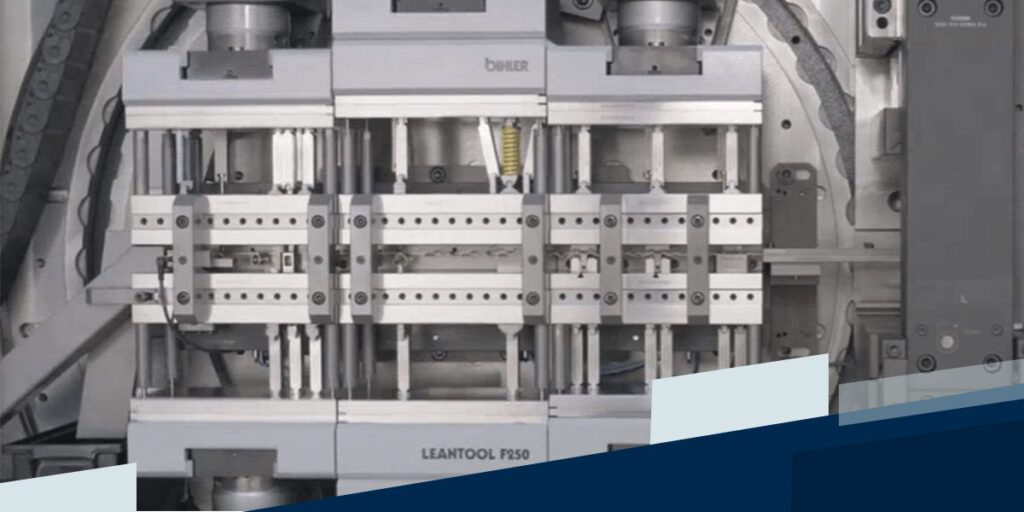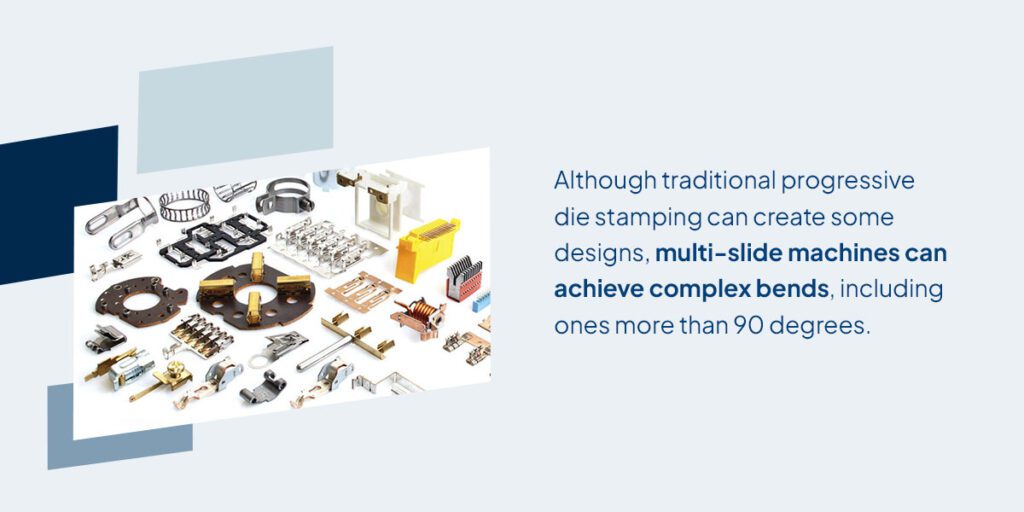
Stamping is an integral aspect of the design and construction in manufacturing processes. Many industries, including mining equipment, aerospace, food and beverage storage and health care, rely on high-quality stamping processes. The designs for these applications continue often require increasingly intricate parts.
Metal stamping is the forming of a shape in metal. A pressing tool, or stamping die, achieves these shapes, and everything from complex medical machines to coins rely on these products. Progressive die stamping and multi-slide stamping are different machines with unique applications.
Keep reading to discover the differences between these machines and the pros and cons of each.
What Is Multi-Slide Stamping?
Multi-slide stamping utilizes tools and dies to create stamped parts from silt coil stock or wire coils. This process includes dies mounted on opposite slides moving horizontally in four directions. Some machines may operate in more than four directions to create more elaborate shapes.
The process begins when metal is fed into the machine. The machine uses actuated cams to stamp and form the desired shape in the metal. This process allows consistent accuracy as the various slides work at right angles and perform multiple folds, adding cuts and bends in a single step. The components eject from the press and move to the production stage upon completion.
What Is Progressive Die Stamping?
Progressive die machines utilize vertical motions to process metal strips. During this process, a slit coil metal moves through various stamping stations with specific operations. At the first station, the die makes the necessary punch, bend or cut. At the next station, the machine performs the stamping function. This cycle continues until the product is complete, which could be a single step or dozens, depending on the design.
A pilot is necessary in pre-pierced holds to keep the metal in place as it moves through the machine because each part is attached to the metal strip during formation. You can apply the Single Minute Exchange of Dies to this process, allowing the die to change easily and quickly to accommodate various designs.
Pros and Cons of Multi-Slide Stamping
Understanding these machines and when to apply their process is essential for efficient and effective stamping processes. You might use them in applications such as automotive, medical device or electronic manufacturing.
Take a look at the advantages of multi-slide stamping and consider if it’s right for your project:
- Faster and cheaper process: Multi-slide stamping can produce hundreds of parts each minute, making it faster than traditional progressive stamping. Those looking for high-volume production runs can rely on multi-slide stamping to save time and money.
- Flexibility: You can create various parts on the same machine by changing the dies, allowing improved flexibility over designs and production.
- Adjustment speed: It’s possible to make micro and complex adjustments to tooling without removing it because the camshafts drive the forming operations. This quick process generates less downtime so that you can spend more time on other functions.
- Less waste: You may save significant costs because these machines produce less scrap. They do not need pilot holes and rely on slotted blank holders to move the parts from one stage to the next. You can also easily access raw materials in specific dimensions.
- Repeatability and precision: You can achieve high-quality precision and repeatability with multi-slide stamping machines.
- Complex part production: Although traditional progressive die stamping can create some designs, multi-slide machines can achieve complex bends, including ones more than 90 degrees. You can also complete multiple cuts, bends, punches or folds within a single step.
- Burr side selection: The forming pressure can apply from any direction, making it possible to select whether the cutting burr will be on the bottom or top of the strip.
Despite the advantages of multi-slide stamping machines, there are several disadvantages to be aware of. Consider these elements:
- Lengthy setups: These complex machines need more time to prepare than traditional progressive die-stamping machines because they have more intricate parts.
- Limited materials: You can only utilize these machines for specific metal sheets due to the way they work. The metal sheets you apply will need to be flexible and thin, meaning these machines may not be acceptable for some applications, including larger parts.
Pros and Cons of Progressive Die Stamping
Progressive die stamping has several benefits compared to other stamping machines. These machines are fit for large parts and allow generic tooling. Review the benefits of progressive die stamping:
- Generic tooling: Due to the vertical pressure and simple forming process, you can move tooling from one supplier to the next without needing a significant retrofit. Typically, you can run a tool built in a different press if the machines have the same tonnage and bed size.
- High accuracy: Each station within these machines performs a different operation, setting the stage for an efficient process that can create large product quantities with high accuracy.
- Repeatability: Progressive stamping machines can produce large quantities without compromising quality and provide outstanding repeatability with tight tolerances.
- Shorter preparation time: Progressive die stamping machines demand less setup time than multi-slide stamping machines. This gives you more flexibility over manufacturing scheduling while generating smaller lot sizes. This can also decrease the labor involved in production.
Although progressive die stamping offers several advantages over multi-slide stamping, you must also consider the drawbacks:
- Increased waste: The machine must carry parts through every step of the process, creating inherent waste to keep the part on the strip. You can recycle or reuse these materials, but the waste can be less cost-effective for some businesses.
- Permanence: This process can be time-consuming and complex. You must configure or reconfigure the setup before each project, making it challenging to switch between various projects quickly.
- Operation limits: You can only utilize progressive die stamping for some projects. You may not be able to produce some part features within these machines.
- Cost: Die sets for these machines can be costly, so you must be sure to generate enough work to offset the initial investment expense.
Meet Your Manufacturing Needs With Bihler of America
Bihler of America is a leading provider of high-speed, precision stamping, tapping and welding products, as well as multi-piece assemblies. We use cutting-edge technology and the latest manufacturing technology and processes to drive excellent results.
The Bihler 4Slide-NC is a versatile machine with automated solutions with industry-first four-slide servo technology. Configurations are tailored to fit your unique needs, but each configuration promises faster production speeds and more efficient production for individual parts. The Bihler 4Slide-NC includes shorter setup times, integrating monitoring and intuitive controls — ultimately saving you time and money.
Contact BihlerMED® for more information about our equipment and services. We look forward to hearing from you.


